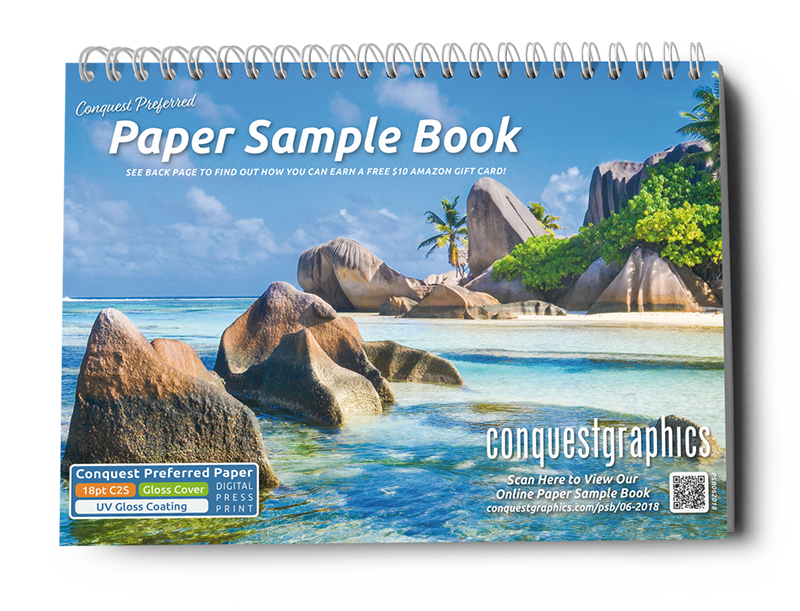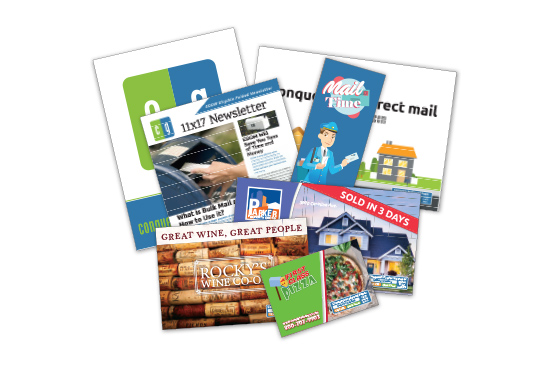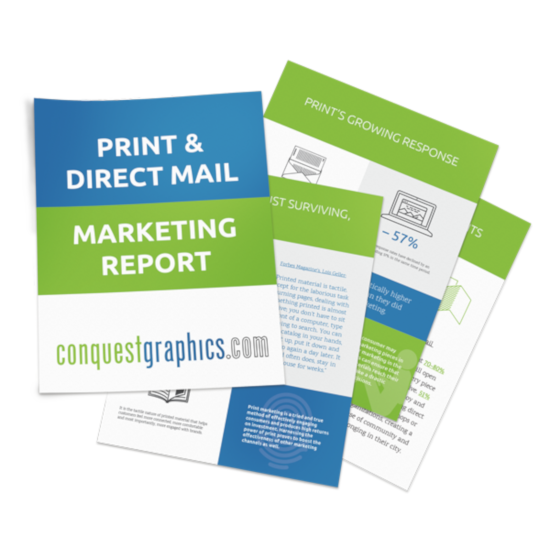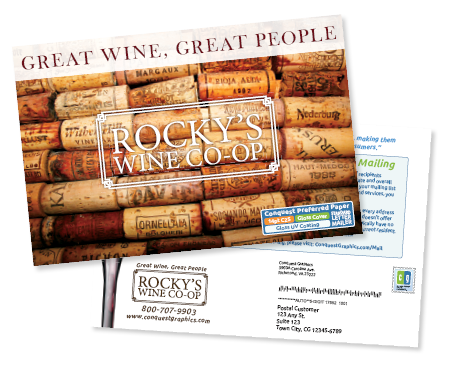Items marked with an asterisk (*) may be obsolete terms that are no longer in common use, but were included for historical accuracy.
A
Accordion fold
Bindery term, two or more parallel folds which open like an accordion.
Against the Grain
At right angles to direction of paper grain. Also known as Across the Grain.
Alteration
Change in specifications after production has begun.
Artboard *
Alternate term for mechanical art.
Author's corrections
Also known as "Author's Alterations". Change in specifications after production has begun.
B
Back up
Printing the second side of a press sheet already printed on one side.
Banding
Method of packaging printed pieces of paper using rubber or paper bands.
Basis weight
Weight in pounds of a paper cut to the basic size for its grade.
Bind
To fasten sheets or signatures with wire, thread, glue, or some other means.
Bindery
The finishing department of a printing company, or a firm that specializes in finishing printed products.
Blanket
The thick rubber mat on a printing press that transfers ink from the plate to the substrate (paper).
Bleed
Printed image that goes beyond the edge of the sheet after trimming.
Blind embossing
An image pressed into a sheet without ink or foil.
Blueline *
A blue photographic proof used to check position of all page elements.
Board *
Alternate term for mechanical.
Bond & carbon
Business form with paper and carbon paper.
Bond paper
Strong durable paper grade typically used for letterhead, business forms, or other office documents.
Break for color
Also known as a color break. To separate mechanically or by software the parts of an image that are to be printed in different colors.
Brightness
The brilliance, reflectance, or relative whiteness of paper.
Bulk
Thickness of paper stock in thousandths of an inch or number of pages per inch.
Bulk pack
Boxing printed product without wrapping or banding. Also known as carton pack.
Burn
Exposing a printing plate to high intensity light or placing an image on a printing plate by light.
Butt
Joining images without overlapping.
Butt fit
Printed colors that overlap by one row of dots so they appear to butt.
C
Carbonless
Pressure sensitive paper, typically used for business forms, that does not use carbon.
Caliper
Paper thickness in thousandths of an inch.
Camera-ready copy *
Print-ready mechanical art.
Carload
A truck load of paper weighing approximately 40000 pounds.
Case bind
A type of binding used in making hard cover books.
Cast coated
Coated paper with a high gloss reflective finish.
Chrome *
A term for a transparency, short for Kodachrome or Ectacrome.
Coated paper
A clay-coated printing paper with a smooth finish.
Collate
A finishing term for gathering paper in a precise order.
Color bar
A quality control mechanism using bands or strips of ink color on the tail of a press sheet.
Color correction
Methods of improving color fidelity and/or quality of color reproduction.
Color filter
Filters used in making color separations, especially during the scanning process.
Color key *
Color proof that uses layers of colored film to show color breaks.
Color matching system
A system of formulated ink colors used for standardized communication of printed colors.
Color separations
The process of preparing artwork, photographs, transparencies, or computer-generated art for printing by separating into the four primary process printing colors, which are cyan, magenta, yellow, and black.
Comb bind
A binding system that uses a plastic comb inserted into specially punched holes.
Composite film *
Combining two or more images on one or more pieces of film.
Continuous-tone copy
Illustrations, photographs or computer files that contain gradient tones from black to white or light to dark colors.
Contrast
The tonal change or dynamic range in color from light to dark.
Copy
All furnished material or data used in the production of a printed product.
Cover paper
A heavy printing paper used to cover books and booklets, to make presentation folders, postcards, etc.
Crash number
Numbering paper by imaging on the first sheet which is then transferred to all parts of the printed set.
Crimping
Special puncture marks that hold multiple-part business forms together.
Cromalin *
Trade name for DuPont color proofs.
Crop
To cut off parts of a picture or image.
Crop marks
Printed lines showing where to trim a printed sheet.
Crossover
Printing across the gutter or from one page to the facing page of a publication.
Cyan
One of four standard process colors. Cyan is a shade of blue.
D
Densitometer
A quality control device that measures the density of printing ink.
Density
An optical measure of color or darkness of colorant (ink) relative to the substrate (paper) in a printed image.
Diazo
A light-sensitive coating used on printing plates.
Die
Metal rule or imaged block used to cut or place an image on paper in the finishing process.
Die cutting
Cutting shapes in or out of a sheet of paper by means of a die.
Dot
An element of halftones. Using a loupe or magnifying glass, you will see that printed images are composed of many small dots.
Dot gain
A term used to explain the difference in printed dot size between the imaged dot on a printing plate and the printed dot on a press sheet.
Double burn
Exposing a printing plate to multiple images.
Draw-down
A sample of ink and paper used to evaluate ink colors.
Drop-out
Portions of artwork that do not print.
Dummy
A rough layout of a printed piece showing position and finished size,
Duotone
A halftone image made up of two printed colors.
Dylux *
Photo-sensitive paper made by DuPont and used for blue lines.
E
Emboss
Pressing an image into paper so that it will create a raised relief.
Emulsion
The light-sensitive coating found on printing plates.
Eurobind
A patented method of binding perfect bound books so they will open and lay flat.
F
Facsimile (FAX)
The process of converting graphic images into electronic signals for transmission over phone lines.
Film RIP *
See RIP.
Flat *
An assembly of negatives taped to masking materials. Used for conventional plate making.
Flood
To cover a printed page with an ink, varnish, or polymer coating. Typical terms are flood varnish, or flood coating.
Flop
The reverse side of an image or press sheet.
Foil
A metallic or pigmented coating on plastic sheets or rolls used in foil stamping and foil embossing.
Foil emboss
Foil stamping and embossing an image onto paper using a die.
Foil stamping
Using a die to place a metallic or pigmented image on paper.
Four-color process
The process of combining four basic subtractive primary colors (cyan, magenta, yellow, and black) to create a printed color picture or colors composed from the basic four colors.
French fold
Two folds at right angles to each other.
G
Galley proof *
Text copy before it is put into a mechanical layout or desktop layout.
Gang
Optimizing the use of a printing press by using the maximum sheet size to print multiple customer jobs on the same sheet. This spreads the cost of plate making and make-ready between multiple customers, and helps save money.
Generation
Number of steps of reproduction from original copy. A first-generation reproduction yields the best quality. Theoretically, digital reproduction has no generation steps.
Ghost bars
A quality control mechanism used to reduce image artifacts caused by heat or chemical contamination during the on-press printing process.
Ghosting
An image artifact that appears on a printed sheet where it was not intended.
Gloss
A shiny appearance that reflects light, usually describes the surface characteristic of a printing paper, or a coating that is applied during the printing process.
Grain
The direction in which the paper fibers lie.
Grippers
The metal fingers on a printing press that hold the paper as it passes through the press.
H
Hairline
A very thin printed line or gap measuring about 1/100 inch.
Halftone
The process of converting a continuous tone image to dots for printing, or a term for the converted image itself.
Hard copy
The output of a computer printer, or typed text.
Hickey
An image artifact composed of multiple undesirable spots that appear in the printed image from dust, lint, dried ink, dirt, or other contamination.
High-bulk paper
A paper that is thicker than its standard basis weight.
Highlight
The lightest or least dense areas in an image or halftone.
I
Image area
Portion of a press sheet on which ink can appear.
Imposition
Positioning printed pages so they will fold in the proper order. Today, this is achieved by use of imposition software.
Impression
The process of putting an image on paper.
Imprint
Imaging onto a previously printed image.
Indicia
Postal information printed on a piece that is to be mailed. It typically contains postal permit information, and appears in the same location in which a postage stamp would be applied.
Ink fountain
The reservoir on a printing press that holds the ink.
K
Keylines *
Lines on mechanical art that show position of photographs or illustrations.
Kiss cut
To die cut the top layer of a pressure sensitive sheet and not the backing.
Knock out
The portion of an image that does not print.
L
Laid finish
A surface characteristic of paper that mimics the feel of handmade paper.
Laminate
To cover with a polymer film, or to bond or glue one surface to another.
Line copy
High-contrast copy or image not requiring the halftoning process. Also called line art.
Lines per inch
The number of rows of dots per inch in a halftone image.
Loupe
A magnifying glass used to review a printed image, proof, or printing plate.
M
Magenta
Process red, one of the subtractive primary colors in process color reproduction.
Make-ready
All the activities required to prepare a press for a print run.
Marginal words
Call-outs for directions on various parts of a business form.
Mask
Blocking the exposure of certain parts of a printing plate.
Matchprint *
Trade name for 3M integral color proof.
Matte finish
A duller appearance than gloss that reflects light, usually describes the surface characteristic of a printing paper, or a coating that is applied during the printing process.
Mechanical *
Camera-ready art that is contained on one board.
Mechanical separation *
An overlay for each color to be printed that is included in the mechanical artwork.
Micrometer
Instrument used to measure the thickness of different papers.
Middle tones
The tones in a photographic image that are approximately half as dark as the shadow area.
Moire
An image artifact that occurs when screen angles interfere with each other, and cause undesirable patterns.
N
Negative
The image on a printing plate that makes the white areas of originals black and black areas white.
Non-reproducing blue
A blue color that cameras and scanners cannot resolve.
O
Offsetting
Using an intermediate surface to transfer ink. Also, an undesirable printing artifact that occurs when the images on freshly-printed press sheets transfer ink to each other.
Offset paper
Term for uncoated text weight paper.
OK sheet
Final approved color inking sheet before production begins.
Opacity
A measure of image show-through on a printed sheet. The more opacity or the thicker the paper, the less show-through
Outline halftone
Removing the background of a picture or silhouetting of an image or picture.
Overlay *
The transparent cover sheet on artwork often used to indicate color breaks or instructions.
Overrun or Overs
Copies printed in excess of the specified quantity. Printing trade terms commonly allow for +/- 5 to 10% of the originally specified quantity to comprise a completed order.
Ozalid *
The name of a company that manufactures and sells diazo process products and equipment that produces ammonia-based blueline prints. Ozalid proofs are most often used in Asia by printers as a proofing system. Most American and European printing companies use digital proofs.
P
Page count
The total number of pages in a book including blanks.
Pattern carbon
Special carbon paper used in business forms that only transfers a written image in certain areas.
Perfect bind
A type of binding that glues the edge of sheets to a cover, similar to a telephone book, Microsoft software manual, or paperback novel.
Perfecting press
A sheet-fed printing press that prints both sides of a press sheet in one pass.
Pica
Unit of measure in typesetting. One pica = 1/6 inch.
Picking
An undesirable printing artifact that occurs as the surface of a press sheet comes off during printing. This problem typically occurs as a result of a paper manufacturing defect.
Pin register
A system used to fit plates to press to ensure the proper registration of printed colors.
Plate gap
Also known as gripper space. The area where the grippers hold the press sheet as it passes through the press.
PMS
The abbreviated name of the Pantone Color Matching System.
PMT *
Abbreviated name for photo-mechanical transfer, a method used to make position proofs.
Point
For paper, a unit of thickness equaling 1/1000 inch and in typesetting, a unit of size equaling 1/72 inch.
PostScript
An industry standard computer language developed by Adobe Systems used in imaging and printing devices. The basic language used in the PDF (Portable Document Format) workflow.
Press number
A method of numbering business forms, race numbers, and tickets. Most commonly used in letterpress and digital printing workflows.
Pressure-sensitive paper
Paper or polymer material with self sticking adhesive covered by a backing sheet.
Process black (black)
Black (process black), one of the subtractive primary colors used in process color (CMYK) reproduction.
Process blue (cyan)
Cyan (process blue), one of the subtractive primary colors used in process color (CMYK) reproduction.
Process colors
The subtractive primary colors used in four-color (CMYK) process printing: cyan (process blue), magenta (process red), yellow (process yellow), and black (process black).
Process red (magenta)
Magenta (process red), one of the subtractive primary colors used in process color (CMYK) reproduction.
Process yellow (yellow)
Yellow (process yellow), one of the subtractive primary colors used in process color (CMYK) reproduction.
R
Ragged left
Type that is justified to the right margin leaving varied line lengths to the left.
Ragged right
Type that is justified to the left margin leaving varied line lengths to the right.
Ream
A sealed package of pre-cut paper, usually containing 500 sheets.
Recto
Right-hand page of an open book.
Reflective copy *
Copy that is not transparent.
Register
To position printed elements in the proper position in relation to the edge of the press sheet and to other elements and/or colors on the same press sheet.
Register marks
Cross-hair lines or marks on plates and paper that help guide plate makers, pressmen, and bindery personnel make correct decisions on how to manufacture printed products.
Reverse
The opposite of what you see. The reverse of this document would be a black piece of paper with a white name. See Negative.
RIP
An abbreviation for Raster Image Processor, a device which processes PostScript files into bitmap images. Frequently used to drive plate makers and digital presses.
S
Saddle stitch
Binding a booklet or magazine with staples in the seam where it folds.
Scanner
Device used to convert hard copy analog images into digital images. Scanners are most likely color scanners, but some specialized monochrome scanners are still used for scanning black and white images.
Score
A crease that is made onto a printed sheet that allows for improved quality of folding.
Screen angles
The angles at which halftones for the four process colors are placed to minimize moiré patterns and provide the best color reproduction quality.
Self-cover
A publication (booklet or magazine) that uses the same weight paper as the text (inner pages) for the cover.
Shadow
The darkest areas of a photographic image.
Show-through
Printed image on one side of a sheet that can be seen on the other side of the sheet. See Opacity.
Side guide
The mechanical device on a printing press that positions a press sheet a certain distance from the side of the paper path.
Side stitch
Binding by stapling along one edge of a collection of pages.
Signature
A sheet of printed pages or images which when folded and/or trimmed, become a part or whole of a book, publication, or other printed product.
Silhouette
A process whereby the subject of a photographic image is removed from the background, typically done in the Adobe Photoshop program.
Skid
A pallet used for storage or transport of a large pile of cut paper sheets.
Specifications
A set of data and information used in the manufacturing of a printed product.
Spine
The binding edge of a book, booklet, or other publication.
Split fountain
Putting more than one color of ink in a printing fountain to achieve special color effects.
Spoilage
Waste that occurs as a result of the manufacturing process. Spoilage may be planned or unplanned spoilage. Unplanned spoilage typically results from poor planning or from manufacturing errors.
Spot varnish
A coating that highlights a specific part of the printed sheet. Not to be confused with a Flood Varnish.
Stamping
Term for foil stamping.
Step-and-repeat
A process by which the same image is positioned on printing plates in multiple locations.
Stet
A proofreading mark indicating that the original copy should not change.
Stock
The material or substrate used for printing, usually paper.
Stripping *
The positioning of images prior to plate making.
Substance weight
A term of basis weight used when referring to bond papers.
Substrate
Any surface on which images are printed.
T
Text paper
Grades of uncoated paper with textured surfaces.
Tints
A shade of a single color or combined colors.
Tissue Overlay *
Usually a thin translucent paper placed over artwork for protection and used for marking color breaks and other instructions.
Transfer tape
A pressure-sensitive tape used in business forms.
Transparency
A positive photographic slide on film that allows light to pass through.
Transparent copy
A film that light must pass through in order for it to be reproduced.
Transparent ink
A printing ink that does not conceal the color under it. Process color inks are transparent inks.
Trapping
The ability to print one wet ink over another. Trapping also refers to the process by which adjacent colors are spread or shrunk in order to eliminate unprinted gaps between colors.
Trim marks
Similar to crop or register marks. These marks show where to trim the printed press sheet.
Trim size
The final size of a printed image after the last trim is made.
U
Under-run
Production of fewer copies than ordered. See Overs.
Up
Printing two or three up means printing multiple instances of the same image on the same sheet.
UV coating
Liquid polymer that is bonded and cured with ultraviolet light.
V
Varnish
A clear coating applied to printed images that improves durability and appearance.
Verso
The left hand page of an open book.
Vignette Halftone
A halftone whose background gradually fades to white.
W
Wash-up
Removing printing ink from a press, washing the rollers and blanket. Certain press operations require multiple wash-ups to avoid ink and chemical contamination.
Waste
A form of spoilage. See Spoilage.
Watermark
A distinctive image or mark created in paper at the time of manufacture that can be easily seen by holding the paper up to a light.
Web
A large roll of printing paper.
Web press
A type of printing press that prints from rolls of paper as compared to sheets of paper.
Wire O
A bindery trade name for mechanical binding using double loops of wire through a set of punched holes.
Wire-O binding
A method of wire binding along that will allow the book to lay flat using double loops. See Wire O.
With the grain
Feeding paper into the press or folder parallel to the grain of the paper.
Work and Tumble
Printing one side of a sheet and turning it over from the gripper edge to the tail edge to print the second side using the same side guides and plate for the second side.
Work and Turn
Printing one side of a sheet and turning it over from left to right using the same side guides and plate for the second side.
Wove paper
A paper having a uniform unlined surface with a smooth finish.









